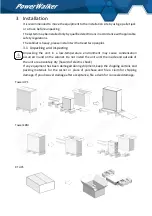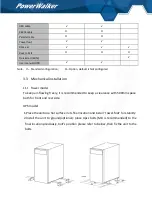
An additional AC contactor is used for back feed protection and must comply with
IEC/EN 62040-1 (the creep age and clearance distances shall meet the basic insulation
requirements for pollution degree 2).
Disconnection and overcurrent protection devices shall be provided by others for
permanently connected AC input (Normal AC/Bypass AC) and AC output circuits.
Check that the indications on the rating plate correspond to your AC powered system
and to the actual electrical consumption of all the equipment to be connected to the
system.
For PLUGGABLE EQUIPMENT, the socket-outlet shall be installed near the equipment
and shall be easily accessible.
Never install the system near liquids or in an excessively damp environment.
Never let a foreign body penetrate inside the system.
Never block the ventilation grates of the system.
Never expose the system to direct sunlight or source of heat.
If the system must be stored prior to installation, storage must be in a dry place.
The admissible storage temperature range is -25°C to +55°C without battery (-15°C to
+40°C with battery).
TN-S/IT/TN-C/TT of electrical supply system may be connected by UPS.
This UPS may be provided with a maximum of 6 extension battery cabinets or equivalent.
Special precautions
The unit is heavy: wear safety shoes and use vacuum lifter preferentially for handling
operations.
All handling operations will require at least two people (unpacking, lifting, installation
in rack system).
Before and after the installation, if the UPS remains de-energized for a long period, the
UPS must be energized for a period of 24 hours, at least once every 6 months (for a
normal storage temperature less than 25°C). This charges the battery, thus avoiding
possible irreversible damage.
During the replacement of the Battery Module, it is imperative to use the same type
and number of elements as the original Battery Module provided with the UPS to
maintain an identical level of performance and safety.
This is a category C3 UPS product. In a residential environment, this product may cause
radio interference, in which case the user may be required to take additional measures.





































